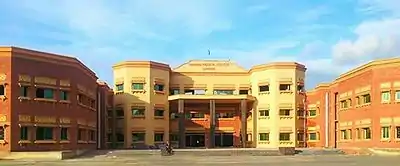Sahiwal
Sahiwal (Punjabi and Urdu: ساہِيوال), formerly known as Montgomery, is a city in Punjab, Pakistan. It is the 21st largest city of Pakistan by population and the administrative capital of both Sahiwal District and Sahiwal Division.[2] Sahiwal is approximately 180 km from the major city Lahore and 100 km from Faisalabad and lies between Lahore and Multan.
Sahiwal
ساہِيوال | |
|---|---|
City | |
    From top to bottom: Sahiwal Railway Station, Ravi Bridge, Chichawatni Forest, Sahiwal Medical College | |
 Sahiwal  Sahiwal | |
| Coordinates: 30°39′40″N 73°6′30″E | |
| Country | |
| Province | |
| Division | Sahiwal |
| District | Sahiwal |
| Government | |
| • Type | Metropolitan Corporation |
| Area | |
| • City | 60 km2 (20 sq mi) |
| • Metro | 3,201 km2 (1,236 sq mi) |
| Elevation | 152.4 m (500.0 ft) |
| Population | |
| • City | 389,605 |
| • Rank | 21st, Pakistan |
| • Density | 6,500/km2 (17,000/sq mi) |
| Time zone | UTC+5 (PST) |
| Calling code | 040 |
| No. of Union Councils | 52 (11 urban, 41 rural)[1] |

The city lies in a densely populated region between the Sutlej and Ravi rivers. The principal crops are wheat, cotton, tobacco,[3] legumes, potato[4] and oil seeds. Cotton goods and lacquered woodwork are manufactured.[5][6]
History
The city was founded in 1865 when a train station was built at the site of a small village on the Karachi-Lahore railway line. The site was named Montgomery for Sir Robert Montgomery, then lieutenant governor of the Punjab and it replaced Gogera as the capital of the recently created Montgomery district.[7] Two years later in 1867, it was constituted a municipality.[8]
In 1914 construction began of the Lower Bari Doab Canal which now irrigates both the city and wider region.[9]
During the Partition of India in 1947 the city, being part of Montgomery district, was allocated to Pakistan by the Punjab Boundary Commission. This was on the basis of being a Muslim majority area, despite claims from the Indian National Congress and Sikh groups on the basis of greater property ownership and revenues paid to the state.[10]
In 1969 the district council approved changing the name of both the city and district to Sahiwal for the Sahi clan of Kharal Rajputs who are native inhabitants of the area.[11]
Climate
The climate of Sahiwal district is extreme, reaching 34 °C in summer, and down to 4 °C in winter. The soil of the district is very fertile. The average rainfall is about 2000 mm.[12]
Education
Notable educational institutes of the city include:
- University of Sahiwal[13]
- COMSATS University, Sahiwal Campus
- Sahiwal Medical College[14]
- Quaid-e-Azam College of Engineering and Technology, Sahiwal
- Punjab College of Science
- The Superior College
- Army Public Schools & Colleges System (APSCS)
- Beaconhouse School System
- Bloomfield Hall School
- The City School
- Divisional Public School and College
- The Educators
- Government Postgraduate College Sahiwal
Twin city
Sahiwal is twinned with the town of Rochdale, in Greater Manchester, North West England. Approximately eight per cent of town's population is of Asian origin, most of whom have links with Pakistan. The twinning arrangement was agreed between Rochdale and Sahiwal in 1998.[15][16]
Notable people
- Mushtaq Ahmed, former test cricketer
- Majeed Amjad, Urdu poet
- Tariq Aziz, television anchor
- Dildar Pervaiz Bhatti, (TV artist, compere, comedian, anchor)
- Brigadier Kuldip Singh Chandpuri, Indian Army Officer
- Attash Durrani, Urdu writer and Scholar
- Manzoor Elahi, former test cricketer
- Rana Mohammad Hanif Khan, politician and former Finance Minister of Pakistan
- Nazir Naji journalist and Urdu columnist for the Daily Dunya
- Emmanuel Neno, Christian author and translator
- Kunwar Mohinder Singh Bedi Sahar, Urdu Poet
- Nouraiz Shakoor, politician and former Federal minister
- Saieen Zahoor, Sufi musician
See also
References
- "Table 209". Punjab Development Statistics 2016 (PDF). Bureau of Statistics, Government of The Punjab. p. 335(340). Retrieved 28 May 2017.
- "Pakistan City & Town Population List". Tageo.com website. Retrieved 29 September 2017.
- Agricultural Research Council (Pakistan) (1 January 1980). Pakistan journal of agricultural research. Pakistan Agricultural Research Council. Retrieved 18 July 2011.
- Nazli, Caesar B. Cororaton, Abdul Salam, Zafar Altaf, David Orden and Reno Dewina, Nicholas Minot, Hina. Cotton-Textile-Apparel Sectors of Pakistan: Situations and Challenges Faced. Intl Food Policy Res Inst. p. 47. GGKEY:1W7L1FH7N4N. Retrieved 18 July 2011.
- The New Encyclopædia Britannica: Micropædia. Encyclopædia Britannica. 1991. ISBN 978-0-85229-529-8. Retrieved 18 July 2011.
- Cotton handbook of Pakistan. Pakistan Central Cotton Committee. 1983. p. 217. Retrieved 18 July 2011.
- "Montgomery District, Imperial Gazetteer of India, v. 17, p. 410., 1860–1922". Dsal.uchicago.edu. Retrieved 2013-02-18.
- "Sahiwal". www.britannica.com. Retrieved 17 January 2021.
- "Sahiwal". www.britannica.com. Retrieved 17 January 2021.
- Ranjan, Amit (20 November 2018). Partition of India Postcolonial Legacies. Taylor & Francis. ISBN 9780429750526.
- District Court Sahiwal. "History of District". www.sahiwal.dc.lhc.gov.pk. Retrieved 17 January 2021.
- ":Govt. Post Graduate College Sahiwal:". Gpgcs.edu.pk. Retrieved 2017-11-08.
- https://uosahiwal.edu.pk
- http://www.slmc.edu.pk
- "Punjab Assembly". Pap.gov.pk. Retrieved 2010-03-24.
- "Town twinning". rochdale.gov.uk. Archived from the original on 29 October 2007. Retrieved 8 August 2016.
